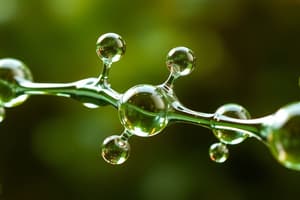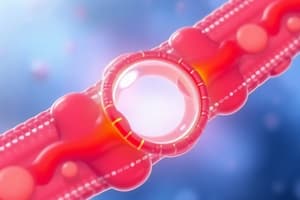Podcast
Questions and Answers
How do phospholipids interact with water molecules?
How do phospholipids interact with water molecules?
- Phospholipids dissolve in water.
- Phospholipids do not interact with water because water is polar and lipids are nonpolar.
- The polar heads interact with water; the nonpolar tails do not. (correct)
- The polar heads avoid water; the nonpolar tails attract water (because water is polar and opposites attract).
What would be the molecular formula for a molecule made by linking three glucose molecules together by dehydration reactions?
What would be the molecular formula for a molecule made by linking three glucose molecules together by dehydration reactions?
- C18H32O16 (correct)
- C18H36O18
- C6H10O5
- C18H30O15
The flow of genetic information in a cell goes from _____?
The flow of genetic information in a cell goes from _____?
DNA to RNA to protein
Identify the functional groups.
Identify the functional groups.
What makes lipids/fats hydrophobic?
What makes lipids/fats hydrophobic?
You disrupt all hydrogen bonds in a protein. What level of structure will be preserved?
You disrupt all hydrogen bonds in a protein. What level of structure will be preserved?
Which of the following is a major difference between RNA and DNA?
Which of the following is a major difference between RNA and DNA?
The complexity and variety of organic molecules is due to _____?
The complexity and variety of organic molecules is due to _____?
Molecules that have the same chemical formula but different three-dimensional shapes are called _____?
Molecules that have the same chemical formula but different three-dimensional shapes are called _____?
What is another name for a condensation reaction?
What is another name for a condensation reaction?
Nucleic acid polymers are made up of ________ monomers?
Nucleic acid polymers are made up of ________ monomers?
Carbohydrate polymers are made up of _________ monomers?
Carbohydrate polymers are made up of _________ monomers?
Protein polymers are made up of __________ monomers?
Protein polymers are made up of __________ monomers?
What functional group contains alcohol?
What functional group contains alcohol?
Which of these groups is characteristic of thiols?
Which of these groups is characteristic of thiols?
Which of these groups plays a major role in energy transfer?
Which of these groups plays a major role in energy transfer?
Which of the functional groups behaves as a base?
Which of the functional groups behaves as a base?
Which functional groups listed below behaves as an acid?
Which functional groups listed below behaves as an acid?
Variations in the reactive properties of different organic molecules are most closely associated with _____?
Variations in the reactive properties of different organic molecules are most closely associated with _____?
What component of amino acid structure varies among different amino acids?
What component of amino acid structure varies among different amino acids?
Most organic compounds contain carbon and _____?
Most organic compounds contain carbon and _____?
What is the name of the process during which a bond between two monomers is broken?
What is the name of the process during which a bond between two monomers is broken?
Flashcards are hidden until you start studying
Study Notes
Phospholipids and Water Interaction
- Polar heads of phospholipids interact with water; nonpolar tails do not.
Glucose Molecular Formula
- Linking three glucose molecules through dehydration reactions results in C18H32O16.
Flow of Genetic Information
- Genetic information in cells flows from DNA to RNA to protein.
Functional Groups
- Amino and carboxyl groups are classified as functional groups.
Hydrophobic Nature of Lipids
- Lipids are hydrophobic due to the presence of relatively nonpolar CH bonds.
Protein Structure Preservation
- Disrupting hydrogen bonds preserves the primary structure of proteins.
RNA vs. DNA
- The major difference between RNA and DNA is the type of sugar present.
Carbon Versatility
- The complexity and variety of organic molecules stem from the chemical versatility of carbon atoms.
Isomers
- Molecules with the same chemical formula but different three-dimensional shapes are known as isomers.
Condensation Reaction
- Another term for a condensation reaction is dehydration.
Nucleic Acid Polymers
- Nucleic acids are composed of nucleotide monomers.
Carbohydrate Polymers
- Carbohydrates consist of simple sugar monomers.
Protein Polymers
- Proteins are formed from amino acid monomers.
Alcohol Functional Group
- The functional group that contains alcohol is the hydroxyl group.
Thiols Characteristic Group
- Sulfhydryl groups are characteristic of thiols.
Energy Transfer Functional Group
- Phosphate groups play a major role in energy transfer.
Basic Functional Group
- The amino group behaves as a base.
Acidic Functional Group
- The carboxyl group functions as an acid.
Reactive Properties of Organic Molecules
- Variations in reactive properties of organic molecules are closely associated with the presence or absence of functional groups.
Components Varying in Amino Acids
- Different amino acids vary primarily in the components of the R group.
Common Elements in Organic Compounds
- Most organic compounds consist of carbon and hydrogen.
Bond Breaking Process
- The bonding between two monomers is broken during the process of hydrolysis.
Studying That Suits You
Use AI to generate personalized quizzes and flashcards to suit your learning preferences.




